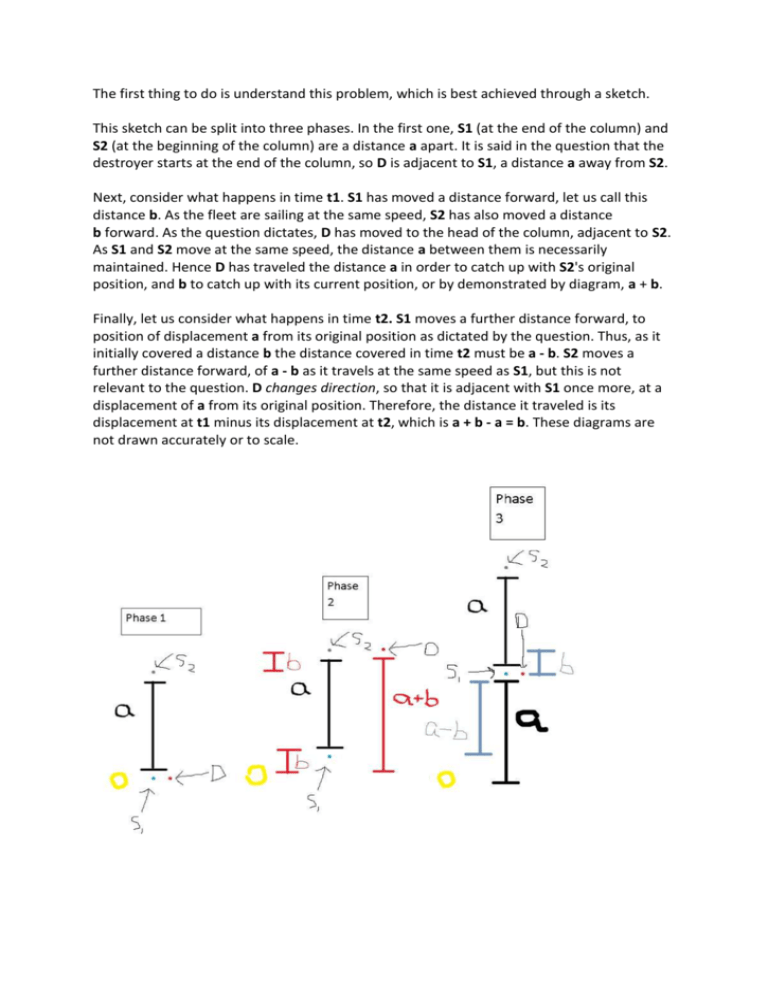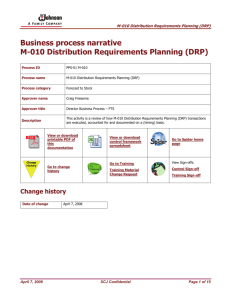The Destroyer Nathan Howard
advertisement

The first thing to do is understand this problem, which is best achieved through a sketch. This sketch can be split into three phases. In the first one, S1 (at the end of the column) and S2 (at the beginning of the column) are a distance a apart. It is said in the question that the destroyer starts at the end of the column, so D is adjacent to S1, a distance a away from S2. Next, consider what happens in time t1. S1 has moved a distance forward, let us call this distance b. As the fleet are sailing at the same speed, S2 has also moved a distance b forward. As the question dictates, D has moved to the head of the column, adjacent to S2. As S1 and S2 move at the same speed, the distance a between them is necessarily maintained. Hence D has traveled the distance a in order to catch up with S2's original position, and b to catch up with its current position, or by demonstrated by diagram, a + b. Finally, let us consider what happens in time t2. S1 moves a further distance forward, to position of displacement a from its original position as dictated by the question. Thus, as it initially covered a distance b the distance covered in time t2 must be a - b. S2 moves a further distance forward, of a - b as it travels at the same speed as S1, but this is not relevant to the question. D changes direction, so that it is adjacent with S1 once more, at a displacement of a from its original position. Therefore, the distance it traveled is its displacement at t1 minus its displacement at t2, which is a + b - a = b. These diagrams are not drawn accurately or to scale. With the aid of our diagram, we can now make some essential conclusions. Labelling the speed of either ship (they are identical) as s and that of the destroyer as d: st1 = b (figure 1) - st2 = a - b (figure 2) - dt1 = a + b (figure 3) - dt2 = b (figure 4) These are just formalised versions of the scenario shown above. We can replace "the distance travelled by s" or "the distance travelled by d" with "s x time elapsed" and "d x time elapsed" as this follows the definition of speed being distance/time, and speed x time therefore being distance. Now we can make some new observations that some may obtain simply from observing the diagram: st1 = b = dt2. (figure 5) This may not seem important, but it is pivotal to solving this problem. With these 5 conclusions, we can ultimately form an equation which we can reduce down by removing a, b, and all times to get exactly what we want - an equation for d in terms of s. Firstly, how can we remove a and b? Well, we shall have to equate them. st2 = a - b - st1 = b. Therefore, st2 + st1 = a. dt1 = a + b - dt2 = b. Therefore, dt1 - dt2 = a. Combining these two equations yields st2 st1 = dt1 - dt2. (figure 6) We now return to the figure 5, st1 = b = dt2. We can remove the b as they both equate to it, so st1 = dt2. Now lets find t1 in terms of the other variables: t1 = (dt2)/s . Making headway, we can substitute t1 into the figure 6's conclusion, and simplify. st2 + s[(dt2)/s] = d[(dt2)/s] - dt2 - Simplify and divide by t2, it is in every term. s + d = (d^2)/s - d - Multiply by s to simplify. s^2 + ds = d^2 - ds - Take away ds and s^2. d^2 - 2ds - s^2 = 0. We now have a quadratic. We need to find d, so we can complete the square with respect the d using s as a constant. (d - s)^2 - s^2 - s^2 = (d -s)^2 -2s^2 = 0. (d - s)^2 = 2s^2 - Square root. d - s = ±s√2 d = s ±s√2 - Add 2s^2. And there is our answer, finalised here for clarity: d = s + s√2. As √2 is positive in this scenario, s√2 will always exceed the value of s, thus s - s√2 will be negative, and the destroyer travel in the opposite direction to s with a smaller velocity. It is absurd in this scenario that said destroyer would overtake s while travelling and reach the head of the column, thus is impossible in this scenario. As this involved so many steps, it is necessary for us to check through a different method to our workings. Let us consider the entire scenario once more. The speed of the ships will be assigned the value 1km/hour. The length of the column is assigned the value 10km. By our formula, the speed of the ship is 10 + 10√2. In phase 1, the destroyer reaches ship S2 from ship S1's initial position. The relative velocity of the destroyer approaching the ship is (10 + 10√2) - (10) (the difference between the ship's and destroyer's velocities, as they travel in the same direction) which is equal to 10√2. As speed = distance/time, distance/speed = time. 10/10√2 = (√2)/2 hours. In this time S1 has travelled a distance [(√2)/2]x[10] = 5√2 kilometres, as has S2, so the destroyer has travelled a total distance of 10 + 5√2 kilometres. Now the ship turns around. Its relative velocity to S1 in equal to (10 + 10√2) + (10) (the addition of their speeds as they are travelling in different directions) which is equal to 20 + 10√2. The distance between the two objects is 10 kilometres, 10 + 5√2 - 5√2. This satisfies the first half of the problem. distance/speed = time = (10)/(20 + 10√2) = (2 -√2)/2 hours until the objects are at the same position. Now we can multiply this by S1's velocity, 10 to give 10 -5√2 kilometres. Add this to S1s displacement at the beginning of this half, 5√2 and we get 10 kilometres. This is equal to the length of the column, so it is now at the head of the column's previous position, satisfying the questions. Now for the destroyer, (10 + 10√2)((2 √2)/2) is 5√2 kilometres. It displacement before turning minus this value is 10 + 5√2 5√2 which yields 10. We have now satisfied the question simply by working through, as the destroyer and ship 1 are in the same position, where the head of the column initially was.










